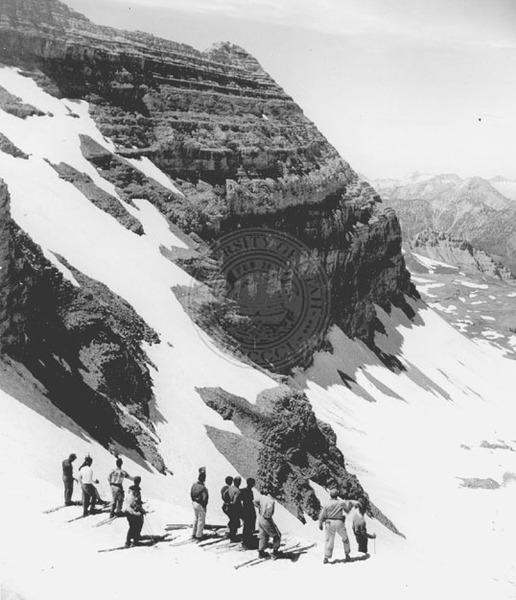Dublin Core
Title
Description
Beginning in 1912, thousands of adventure-seekers hiked up the back of Mt. Timpanogos each summer to ski down a small permanent snowfield called the “Timp Glacier.” For nearly sixty years, they took to the mountain every July to summit the peak on what was called the “Timp Hike”. Beyond just hiking, this weekend extravaganza included camping, bonfires, and – in some years – glacier ski races. The annual Timp Hike was hugely popular, and also a strain on the mountain’s fragile ecosystem.
In the early 1940s, heavy snowfall covered the rocky landscape in a thick layer that lasted through the summer months, allowing hikers to ski or slide down the mountain in July. Skis, boots, and poles were loaded onto horses and toted up the snowfield. The “Glacier Cup” competition attracted both viewers and participants, with local ski talents competing for bragging rights.
Although organizers set the course with utmost attention to safety, the dangerous nature of the Glacier Cup race only added to the thrill. Snowdrifts, boulders, and crevasses could prove deadly not only for skiers but also for hikers planning to slide down the mountainside. Falls were common, and with thousands of people hiking, skiing, and glissading, the risk for injury was high. Despite potential danger, interest in the Timp Hike and the Glacier Cup competition only grew, with record numbers of participation in 1949.
Unfortunately, the summer ski seasons were short lived, and alternating dry and wet seasons threatened the size of the snowfield. Despite the semi-permanent appearance of snow, the field never recovered to the size that it was in the 1940s. Seasonal changes and the popularity of the Timp Hike also took its toll on the landscape. Abandoned trash and the destruction of flora and fauna during the weekend celebration threatened the health of the ecosystem and in 1970 the Timp Hike was formally disbanded. The diminishing snowfield continues to serve as a visual reminder of the lasting impact of human recreation on the environment.
Creator
Source
_______________
See Dean R. Brimhall, “A Winter Acquaintance with Timpanogos,” Utah Historical Quarterly 49, no. 4 (1981): 344; Sandy Eldredge, “Are There Glaciers in Utah's Mountains?” Utah Geological Survey; Alan K. Engen, Skiing, a Historical Snapshot: Ski History Years 1940 - 1946; Friends of the Utah Ski Archives; “Suzy Harris Rytting,” Utah Ski Archives Newsletter 23 (2004): 5; Jack Goodman, “Wandering in the Wasatch," Utah Historical Quarterly 27, no. 3 (1959): 324-25; “Mass Hikers in the Sky,” Sports Illustrated, July 15, 1957: 38; Jim Rayburn, “Snowfields in Mountains Look Deceptively Peaceful,” Deseret News, July 25, 1997; “Steward Family Legacy: Beneath Mount Timpanogos,” Mountain Express Magazine Park City, 2018.

